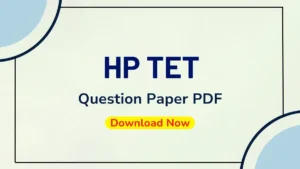Table of Contents
In many teaching exams including CTET 2023, MPTET 2023, STET 2023 etc. English language is as essential part of the various GOvernmnet Teaching Exams such as CTET, and State TET along with Teaching Job Exams such as DSSSB, KVS, NVS, etc. In CTET, candidates have to answer 15 questions on English content and 15 questions on English Pedagogy in CTET and other State TET Exams. In English Pedagogy is one of the interesting and scoring topics under the English Language sections of teaching exams.
In this article, we are providing detailed information on of the most important topics of English pedagogy – Evaluation of Communication.
What is the Evaluation of Comprehension?
Evaluation of comprehension in English pedagogy refers to the process of assessing a student’s understanding and interpretation of written or spoken language. It involves gauging how well a student comprehends the meaning, ideas, and context conveyed in various texts, such as passages, articles, stories, poems, or dialogues. This evaluation is crucial for language educators to measure a student’s language proficiency, reading skills, critical thinking abilities, and overall grasp of the English language.
Importance of Evaluation
Evaluation helps the teacher to know whether the teaching methodology adopted was successful or not. It helps the teacher to know how successful students were in learning new skills i.e. LSRW. The evaluation also helps the students to determine which area of learning requires more attention.
Steps of Evaluation
The evaluation process in English pedagogy, particularly for assessing comprehension, typically involves the following steps. In the section, the steps of evaluation are mentioned.
• Determine educational objectives
• Organize learning experiences
• Measure behavioural changes
• Perform tests
Continuous and Comprehensive Evaluation (CCE)
Continuous and Comprehensive Evaluation is a system which was introduced by CBSE in India to assess all aspects of a student’s development on a continuous basis throughout the year. It covers both scholastic subjects as well as co-scholastic areas such as performance in arts, music, dance, sports, athletics and other cultural activities. Some students are not good in academics but can excel in other extracurricular activities.
• Continuous denotes regular and continuous activities conducted throughout the year to achieve all-round development.
• Comprehensive suggests mental, emotional and physical aspects of the student’s progress i.e. all-round development of the student.
• Evaluation suggests a variety of tools and techniques which are used to assess and evaluate the student’s progress.
Objectives of CCE
Some of the objectives of CCE are as follows
• To develop cognitive, psychomotor and affective skills.
• To lay emphasis on thought processes and de-emphasize memorization. To make an evaluation as an integral part of the teaching-learning process.
• To use evaluation as a quality control device to maintain the desired standard of performance.
• To make the process of teaching and learning a learner-centered activity.
Scholastic aspects include curricular areas or subject-specific areas, whereas co-scholastic aspects include life skills, co-curricular activities, attitudes and values.
Importance of the CCE Scheme
It will reduce stress and anxiety which often build up during and after the examination which could have an adverse effect on learners.
• It will reduce the dropout rate as there will be less fear and anxiety.
• The emphasis on conceptual clarification through experimental learning in the classroom will increase.
• It will help the learners to develop holistically in terms of personality by also focusing on the co – scholastic aspects which will also be assessed.
• The student will have more time on their hands to develop their interest, hobbies and personalities.
• It will motivate learning in a friendly environment than in the fearful situation.
• It provides information and helps in making decisions for the future, regarding choice of subjects, courses and careers.
Formative Assessment
Formative Assessment is a tool to continuously monitor student progress in a non-threatening supportive environment. It involves regular feedback, a chance for student to reflect on the performance and improve upon by taking advice.
Features of Formative Assessment
• It is diagnostic and remedial.
• It provides a platform for the active involvement of students in their own learning.
• It enables teachers to adjust teaching to take account of the results of assessment.
• It builds on student’s prior knowledge and experience in designing what is taught.
• It offers an opportunity to students to improve their work after they get the feedback.
• It helps students to support their peer group and vice-versa.
Tools and Techniques of Formative Assessment
Tools and techniques for Formative Assessment are as follows
| Tools | Techniques |
| Questions | Examination |
| Observation schedule | Assignments |
| Interview schedule | Quizzes and competitions |
| Checklist | Projects |
| Rating scale | Debates |
| Anecdotal records | Elocution |
| Document analysis | Group discussion |
| Tests and Inventories | Club activities |
| Portfolio analysis | Experiments, Research |
Description of Some Tools of Formative Assessment
• Observation: It helps in identifying the various aspects of a student’s personality development. Techniques like debate, elocution, group work, practical and laboratory activities, projects, etc. can be used.
• Rating Scale: It is used wherever a response or learner behaviour is likely to be on a continuum from excellent to bad or from satisfactory to unsatisfactory. It can be used to assess individuals as well as groups.
• Anecdotal Record: It is a record of the conduct, thinking, skills and capabilities revealing significant features of his/her personality and proving very helpful in understanding a child’s behaviour in diverse situations.
• Portfolio: It is a cumulative record of growth and development of a skill or competence in an area over a period of time. It helps the students to demonstrate to others his/her learning progress. A Portfolio may include photographs, paintings, audio-video recordings and self-assessment sheets, peer assessment sheets.
Summative Assessment
This is carried out at the end of a course of learning. It measures or ‘sums up’ how much a student has learnt from the course. It is usually a graded test. It certifies the level of achievement only at a given point in time.
Features of Summative Assessment
Summative Assessment methods are the most traditional way of evaluating student work. Summative Assessments are often high stakes meaning they have a high point value.
• In summative assessment the technique used in examination system and the tools used are pen and test paper.
• This test may include objective-type questions, short answer-type questions and long answer-type questions.
• Questions as a tool are primarily used in examination and to find out what children know, think and feel.
• A good test in English should be based on the objectives of teaching English in our schools i.e. development of listening, speaking, reading and writing skills in the students.
DOWNLOAD ENGLISH STUDY NOTES PDF




 UP ECCE Educator Salary 2025, Check Basi...
UP ECCE Educator Salary 2025, Check Basi...
 OTET Admit Card 2025 Out, Download Hall ...
OTET Admit Card 2025 Out, Download Hall ...
 HP TET Question Paper 2025, Download Art...
HP TET Question Paper 2025, Download Art...




